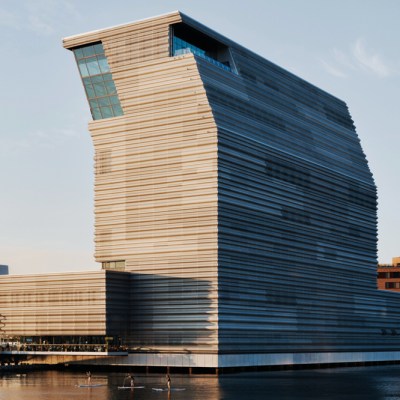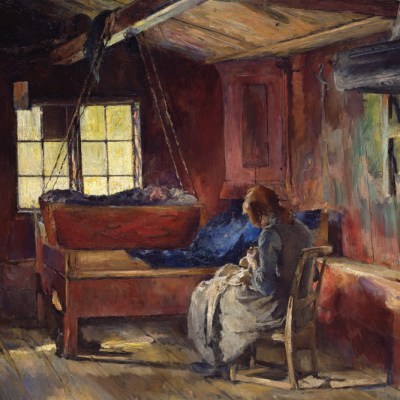From the June 2024 issue of Apollo. Preview and subscribe here.
On the southern tip of Norway, 150km or so from Denmark, lies Kristiansand, a city of 100,000-odd people built around the Otra estuary. Connected to the mainland via several small bridges is Odderoya, a mile-long island whose rocky, forested trails contain the remnants of fortifications built at the turn of the 19th century that helped fend off (if only for a few hours) a German attack in April 1940. As I set off to explore Odderoya, I look back and see a vast cruise liner, the 5,000-capacity Costa Diadema, pulling into Kristiansand port, almost dwarfing the city behind it.
It is not the most exciting arrival in Kristiansand that week. Kunstsilo, a museum constructed from the skeleton of a 1930s grain silo and dedicated to Nordic art, has just opened its doors for the very first time. Architecturally it is a very different prospect from the rusting bunkers just a mile or so away and the megalith moored in the harbour, but in an odd way it shares something with both structures. Kunstsilo is an act of fortification, an attempt to shore up the region’s cultural reputation, an emblem of patriotism. It’s also a vehicle designed, like the Costa Diadema, to bring in the crowds.
The Sun (1968), Synnove Anker Aurdal. Photo: Vegard Kleven; © Kunstsilo; © BONO, Oslo, 2024

Kunstsilo is the brainchild of 57-year-old Nicolai Tangen, an investment banker and manager of the Norwegian Sovereign Wealth Fund – the largest oil fund in the world, with an estimated value of $1.6 trillion. Tangen is a curious figure from afar, a workaholic financier (he keeps a calendar in his office counting down the days until his tenure ends, to inject ‘urgency’ into his team’s mindset) who also studied art history at the Courtauld and, over the last three decades, has amassed the most extensive private collection of 20th-century Nordic art in the world. In 2015, Tangen decided to donate the whole lot to Kristiansand, his home city, and his eye fell upon the huge silo, unused since 2006, as a fitting home.
As chairman Stein Olav Henrichsen acknowledges at the museum’s grand unveiling, its genesis has been controversial. Although much of the £52m required to build the museum comes from private sources, including Tangen’s own foundation, some residents of Kristiansand objected when they discovered that public funds would make up a hefty chunk of the bill. The dispute led to the mayor who signed the deal losing his job.
Nonetheless, it’s a stunning place. The museum’s architects, a triumvirate of firms based in Barcelona, Mestres Wage Arquitectes, BAX and Mendoza Partida, have chosen to retain as much of the original building as possible. The silo’s giant columns are still visible from the outside and, as you walk through the galleries, every now and then you find a section of concrete cylinder rising through the space from floor to ceiling. The stairwells, too, are corkscrewed inside some of the shafts. There is something congruous about the combination of these physical reminders of the place’s industrial past and much of the art on display, particularly the social realist and proletarian work of the 1930s, such as Reidar Aulie’s Strike (1936), an atmospheric canvas depicting striking workers flooding out of a factory in the snow, or the quasi-Cubist Masons (1932) by Carl von Hanno (whose painting The Unemployed (1933–34) is a minor masterpiece but is unfortunately not part of the collection).
Installation view of Gjerdeloa (1980) by Marianne Heske, with its resin-based companion piece. Photo: © Alan Williams; © Marianne Heske Prosjekt Gjerdeloa

From Tangen’s 5,500-strong hoard, three floors and 25 rooms’ worth of works have been selected to make up Kunstsilo’s opening exhibition. ‘Passions of the North’ is a tour of 20th-century art by artists from Norway, Sweden, Finland, Denmark and Iceland that ranges from works influenced by Fauvism, cubism, Surrealism and Expressionism, through machine aesthetics, 1930s modernism, geometric paintings, textiles, pottery, photography, sculpture, political and conceptual art, and everything in between. The aim, says Henrichsen, is to give a fuller picture of Nordic art than was available before – not all that difficult, given how vanishingly few of these artists are known by foreign critics. Edvard Munch, who left his whole oeuvre to the city of Oslo, is conspicuous by his absence.
‘I tried to create a sense of melody or musical development,’ the curator, Asmund Thorkildsen, tells me. ‘I didn’t take into account anything to do with age, sex or nationality. It was just about seeing the work, a visual reality,’ he says. As a result, this imposing exhibition is structured in an instinctive manner. Each room strikes a very different note: some are quite minimalist, while others combine sculpture with hanging works. Often, canvases are bunched tightly together – partly a result of the sheer number of things in the show, one suspects, even though Thorkildsen tells me that he was ruthless in his selection. Works are grouped into conceptual categories (example: ‘The World Dismantled and Reassembled’) rather than straightforward generic or chronological ones. It’s an esoteric mode of curation, Thorkildsen remarks, explaining that the whole thing took him only a couple of days to map out.
From the Artist’s Studio (c. 1953), Johs. Rian. Photo: © Kunstsilo; © BONO, Oslo, 2024

Unconventional as it may be, it’s a nicely characterful approach. One room on the third floor, dedicated to ‘Form Familes’ and ‘Geometric Abstraction’, is bisected by a large green frame-type structure that runs from one wall to the opposite. On one side are some bright, angular abstract works from the later 20th century by Jorma Hautala, Olle Baertling and others; on the other is a perfectly white canvas by Arne Malmedal from 1992–93 – an invigorating contrast to the bold colours of the geometric pioneers – and below that a table crammed full of beautiful ceramic vases and jugs. Looking at the room as a whole is like looking at a still life, with a succession of wildly varied but somehow harmonious objects; a moment of exhilarating curation in which the room becomes a kind of meta-artwork itself.
The most obviously innovative aspect of Kunstsilo is its digital arm, S-Lab – the part that ‘audiences love’, says Torill Haugen, the museum’s head of digital mediation and innovation, but that ‘critics may hate’. Working with artists, computer programmers and a specially built robot, S-Lab has devised a method of creating dynamic digital reproductions of artworks – ‘immersive art mediations’ is Haugen’s phrase – that are housed in a room off a first-floor corridor. The flagship digitised work is by Reidar Aulie, whose works number some 34 in the Tangen collection: Tivoli (1935), a manic depiction of an Oslo fairground populated by eerie and (whisper it) vaguely Munch-like figures. The painting itself sits at the end of a long white corridor, from which you can then move through to see the digital version in the next room.
Tivoli (1935), Reidar Aulie. Photo: Oystein Thorvaldsen; © Kunstsilo; © BONO, Oslo, 2024

Stepping into the room is a heady experience. In the painting, the faces blend into one mass; in the immersive version, projected on to all four walls of the room, each individual, blown up to many times their original size, has been cut loose and given the gift of movement. There is something highly effective and unsettling about these figures stumbling jerkily around the walls while gloomy fairground noises and the din of crowds is piped through the room. ‘It works,’ Haugen tells me, ‘because it’s only a small part of the whole art collection, and because the real work is just around the corner.’
I think she’s right. ‘I saw the Frameless exhibition of Munch’s paintings in London,’ Haugen continues, ‘and it was just like “copy and paste” with some added music. This needed to be different.’ If immersive art is something that we will have to accept is here to stay, then this feels like a blueprint for how it should be done: a well-produced, inviting way of reimagining works that doesn’t detract from the experience of seeing the original (and is eminently skippable for those who don’t want to try it).
Henrichsen says that Kunstsilo’s projects will help foster a sense that Nordic art is its own school, free from the shackles of French and German dominance. Certainly, some of the most enticing work here is distinctly, self-consciously Nordic: Synnove Anker Aurdal’s glorious large-scale textile The Sun (1968) takes inspiration from traditional Norwegian weaving traditions; Marianne Heske’s Gjerdeloa is a 400-year-old log cabin that the artist uprooted from a village in western Norway and reconstructed for the Bienniale de Paris in 1980, and is now a permanent, enterable fixture of the Kunstsilo’s upper floor, along with its companion cabin made from resin by Heske. There are four canvases, enigmatically abstract and figurative at the same time, from 1947 by Ib Geertsen, the Danish painter who co-founded the Linien II artists association that same year, a group that aimed to forge a specifically Danish brand of concrete art.
Figure in Motion (1947), Ib Geertsen. Photo: Oystein Thorvaldsen; © Kunstsilo; © BONO, Oslo, 2024

Yet a collection like this, based on nations and land borders above all, serves to show how porous such boundaries are. The first artwork ever bought by Tangen, From the Artist’s Studio by Johs. Rian (c. 1953) is a variation in blue on Matisse’s The Red Studio (1911). Elsewhere in the collection there are canvases by Anna-Eva Bergman that resemble works that Kandinsky was making 30 years earlier; and paintings by Wilhelm Freddie, Erik Olson and others that look indistinguishable from some of the more famous Surrealist art being produced across the continent at the time.
One of the most prominent artists in the collection, and the artist whom Tangen wrote about in his dissertation while at the Courtauld, is Rolf Nesch. His large metal panels Elbbrücke (1932) – one of a joyous series of views of Hamburg bridges – and Music, Triptych (1934–35), with its mellifluous figures, are two of my favourite pieces in the whole collection. But is it right to think of him as a Nordic artist, given that he was born in Germany, moved to Norway at the age of 40 and painted countless works with German subjects?
Perhaps we should be wary of taking this very specific – albeit huge, and often high-quality – collection of works according to the taste of one very rich man as a comprehensive survey of modern Nordic art. But this is less a criticism of Kunstsilo than of the labels the art world relies on. The place itself is well worth a visit – for the spectacular architectural feat, for a view of a much-neglected body of 20th-century art and for the sheer beauty of the surroundings. Visitors to the various shrines to Munch in Oslo – where new iterations of the Munch Museum and the National Museum opened in 2021 and 2022 respectively – might like to take the picturesque, four-hour train ride down the coast to Kunstsilo to compare. As Henrichsen says, echoing what every local I speak to says about the city’s warm(ish) climate, ‘people used to come to Kristiansand for the weather. Now they will come for the art, too.
Music, Triptych (1934–35), Rolf Nesch. Photo: Oystein Thorvaldsen; © Kunstsilo; © BONO, Oslo, 2024

From the June 2024 issue of Apollo. Preview and subscribe here.


